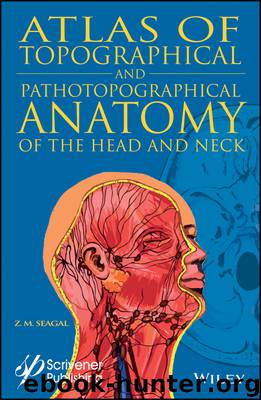Atlas of Topographical and Pathotopographical Anatomy of the Head and Neck by Seagal Z. M

Author:Seagal, Z. M. [Неизв.]
Language: eng
Format: epub
ISBN: 9781119459767
Publisher: John Wiley & Sons, Inc.
Published: 2017-11-27T19:21:00+00:00
In the buccal region the cellular tissue is the most developed and Bichat’s fat pad (located between the buccal and masticatory muscules) is attached to it. Muscles of expression of the buccal region are presented by the lower part of m. orbitalis oculi, m. quadratus labii superiors, m. zygomaticus. Afferent nerves are the branches of n. trigeminus – n. infraorbitalis and nn. buccalis. Efferent nerves are the branches of n. facialis.
Layers and their characteristics. The skin of the buccal region is quite thin and contains a large amount of sweat and sebaceous glands. It is firmly attached with the well-developed layer of the cellular tissue. Facial artery and vein proceed inside the cellular tissue.
Buccal fat pads are practically important formations which are located in the subcutaneous layer. They are also known as Bichat’s fat pads and corpus adiposumbuccae. They are located at the back of the posterior limit and attach to the frontal edge of the masticatory muscle. Buccal fat pads are enclosed into a quite tight fascial capsule, which separates it from the cellular tissue and buccal muscle located deeper.
One part of the pad is located in an adjacent, parotid-masticatory area, between the deep surface of the m. masseter and the m. buccinator. There are several processes coming from this part of the pad: temporal, orbital and pterygopalatine, that proceed into the corresponding regions. The temporal process follows the zygomatic bone along the outer wall of the orbit through masticatory-maxilar space and reaches the front edge of the temporal muscle. Here this process attaches with subfascial temporal space and the deeper temporal space (between the bone itself and deep surface of temporal muscle). Orbital pad process is located in the infratemporal fossa adjacent to the lower orbital fissure. Pterygoid-palatal pad process proceeds further into the outer basis of the cranium between the posterior edges of the upper and lower jaw and the base of the pterygoid process. Sometimes this process reaches the lower medial part of the superior orbital fissure and enters into the the skull cavity through it, where it attaches to the wall of intracavernous dural sinus.
Blood vessels. The blood supply is performed by a. carotis externa: a. temporalis superficialis, a. ficialis, maxilaris and a. ophthalmica (from a. carotis interna). Facial artery and vein in the buccal region are projected from the intersection of the anterior edge of the masseter muscle with the lower edge of the lower jaw in the diagonal direction to the inner corner of the eye. One of the most important facial vein anastomoses with pterygoid plexus can be found on this line approximately on the level of ala nasi. There are two venous nets on the face: superficial (consists of facial and submandibular veins) and profound (is presented by pterygoid venous plexus).
The projection of the branches of the facial nerve, parotid gland, and the exit points of trigeminal nerve’s branches. Motor branches of the facial nerve that innervates the mimic muscles are projected along the lines diverging in a fan manner from a point lower and forward to the tragus.
Download
This site does not store any files on its server. We only index and link to content provided by other sites. Please contact the content providers to delete copyright contents if any and email us, we'll remove relevant links or contents immediately.
| Administration & Medicine Economics | Allied Health Professions |
| Basic Sciences | Dentistry |
| History | Medical Informatics |
| Medicine | Nursing |
| Pharmacology | Psychology |
| Research | Veterinary Medicine |
Dynamic Alignment Through Imagery by Eric Franklin(3925)
Body Love by Kelly LeVeque(2908)
Barron's AP Calculus by David Bock(1724)
EMT Exam For Dummies with Online Practice by Arthur Hsieh(1618)
The Juice Lady's Remedies for Asthma and Allergies by Cherie Calbom(1524)
Fitness Walking For Dummies by Liz Neporent(1470)
Flight by Elephant(1420)
Extremes: Life, Death and the Limits of the Human Body by Fong Kevin(1420)
McGraw-Hill Nurses Drug Handbook by Patricia Schull(1401)
The Natural First Aid Handbook by Brigitte Mars(1334)
Tell by Major Margaret Witt(1316)
Skin by Unknown(1300)
Seeing Voices by Oliver Sacks(1286)
Born to Walk by James Earls(1251)
Cracking the Nursing Interview by Jim Keogh(1217)
The Yoga Bible by Christina Brown(1198)
First Aid for Colleges and Universities (10th Edition) by Mistovich Joseph J. & Limmer Daniel J. & Karren Keith J. & Hafen Brent Q(1193)
The Advantage by Lencioni Patrick M(1103)
Living Ready Pocket Manual - First Aid: Fundamentals for Survival by James Hubbard(1100)
